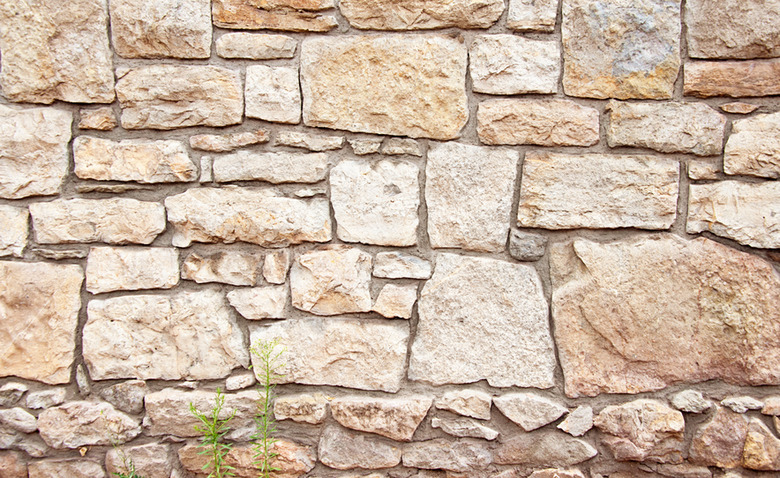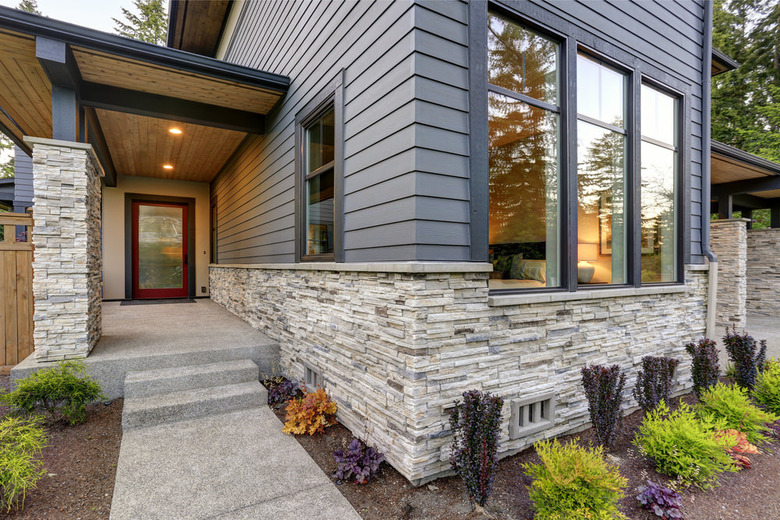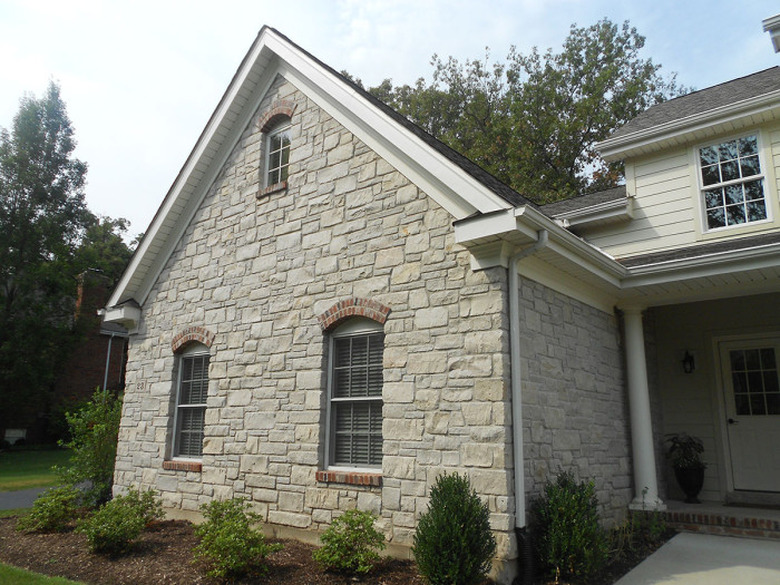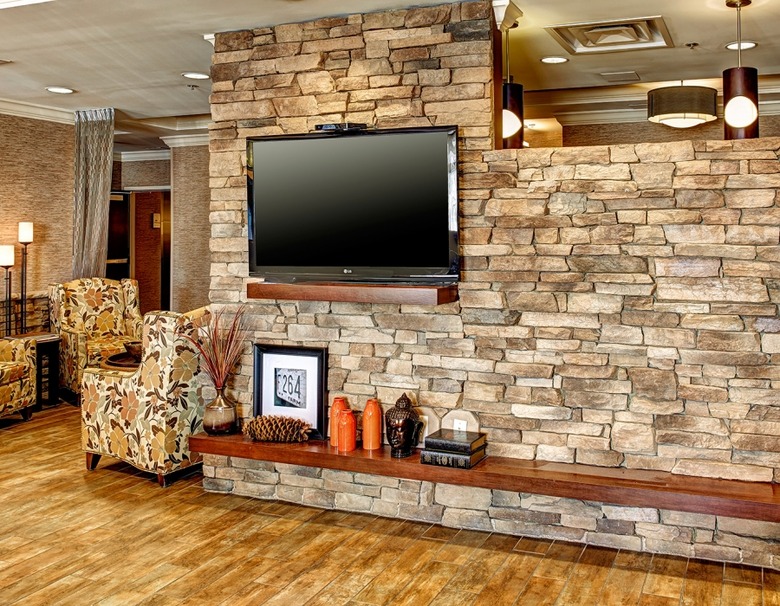An Introduction To Stone Veneer Siding
Who isn't charmed by a snug stone cottage or impressed by an imposing stone façade? Harkening back to centuries-old construction methods and materials, stone—or the appearance of stone—conveys a sense of solidity and permanence. Facing a home with actual solid stone, however, is hardly practical anymore. Genuine, solid-stone siding is too costly for all but the wealthiest homeowners, requires skilled masons in its application, and is extraordinarily heavy, requiring a brick ledge extending out from the foundation for support. If the brick ledge wasn't part of the original construction, it's difficult to add later. Brick can be charming and also conveys a sense of permanence, but facing with real brick poses problems similar to stone—brick is heavy, requires a brick ledge and the services of skilled masons. To achieve the ambiance and appeal of natural stone while keeping the cost within reasonable limits and adhering to modern construction standards, builders turn to veneers of sliced real stone and faux stone siding.
Real Stone in Convenient Slices
Real Stone in Convenient Slices
Sliced real stone siding is, exactly as it sounds, uniformly thick slices cut from quarried stone or fieldstone. The advantages of real stone siding are the obvious ones—it's extremely durable and each piece is unique. Applying real stone siding to an exterior is labor intensive, as the stones must be sorted and individually placed, taking special care to maintain a consistent randomness of shape, size and color. The heaviness of the natural material may also conflict with building codes—many codes restrict the weight of stone siding to 15 pounds per square foot. If the stone siding is not properly installed, the mortar between the stones can crack, admit moisture and create conditions for mold and rot.
The Faux Stone Alternative
The Faux Stone Alternative
Faux stone veneer is man-made, usually of Portland cement with lightweight fillers such as pumice, tinted with natural or artificial pigments, then cast in molds prepared from real stones. Some faux stone is also manufactured from high-density polyurethane. Quality faux stone veneer is colored with ten or more pigments and the cement slurry vibrated in the molds to achieve a natural swirl and mix of colors. Beware the lowest grades of faux stone, which may be only superficially painted and destined to eventually fade.
While some faux stone siding is produced in individual pieces, like real stone, many of the faux stone veneers are sold as assembled panels measuring from two to eight square feet. Molded L-shaped pieces are provided to seamlessly turn the corner. Some manufacturers even offer matching sills and keystone pieces for arches. Available stonework styles range from imitation fieldstone, which calls for grouting mortar joints between the pieces, to dry-stacked styles that require no grouting at all. The preassembled panels greatly facilitate installation, of course, but they limit the installer's ability to randomize the masonry pattern. Look carefully and you can find repeats. Manufacturers design faux stone panels to be affixed with screws or mortar or both.
Lumpy Stucco
Lumpy Stucco
Cement-based faux stone is sometimes referred to as "lumpy stucco" by building science experts. That appellation is useful, as it is a reminder of the limitations and special requirements of faux stone veneer. Just because it looks like stone doesn't mean the siding will perform like stone. Cement is a fairly absorbent material and faux stone siding will soak up water and retain it unless special provisions are made to permit drainage and air circulation to dry the siding out. This absorbent nature of cement-based siding doesn't disqualify it as a worthy exterior treatment, however. Contrary to popular perception, few siding products are waterproof, nor are they expected to be. Since even the most water-resistant materials will be penetrated by rainwater somewhere—at corners, windows, doors or flashings—the builder's correct response to unavoidable moisture infiltration is an installation system that controls and channels it.
That control is achieved through the proper employment of drainage planes. Typical drainage plane materials are tarpaper, building paper or house wrap overlapped shingle-fashion. Because of the absorbent properties of faux stone veneer products, correct usage of drainage planes is essential to good long-term performance of the siding. One way or another, moisture is sure to get in, and drainage planes are meant to stop that infiltration before it reaches the house's wood framework, insulation or drywall, and to condense and channel that water down and out of the siding/mortar matrix.
In order for the drainage plane to be most effective, there must also be air circulation behind the masonry. This can be accomplished by the use of lath strips outside the waterproof wrap, or by the use of special drainage mat material designed to maintain an air space behind the siding.
Correct Installation is Critical
Correct Installation is Critical
Proper installation of stone veneer siding also requires a margin of at least four inches between the bottom of the siding and the soil and at least two inches between the siding and any pavement, decking, or roof surface if the siding continues past the roof, such as on a chimney. The bottom of the siding should terminate in a weep screed, which provides an exit for any accumulated moisture. In addition, wherever the stone veneer siding meets another material, like a window or door, a gap of at least 3/8 inch should be left. This gap is filled first with foam backer rod and then topped with flexible caulk.
Failure to install faux stone siding correctly can result in deterioration of the siding itself, and can cause mold and severe structural degradation to the home on which it is applied. Remarkably, some building inspectors report that 90 to 100 percent of the stone veneer they see is installed incorrectly.
Bringing Stone Veneer Inside
Bringing Stone Veneer Inside
As popular and attractive as stone veneer has proven to be in exterior applications, that's not the limit of its appeal. The color and texture of stone veneer can create dramatic interior applications, as well. Used to surround a fireplace or for rustic contrast in a room, stone veneer used inside suffers none of the moisture problems inherent in exterior siding. And, because the preparation for installing an interior stone veneer surface is less rigorous, it falls within the capabilities of any reasonably skilled do-it-yourselfer.
There are many stone veneer products on the market, and they offer a wide range of appearances. Each home improvement outlet seems to have its own preferred suppliers. If you are considering stone veneer, either for siding or for an interior surface, the best advice is to shop around, see the materials in person, and get a sense of what is possible in the art of simulating stone.



